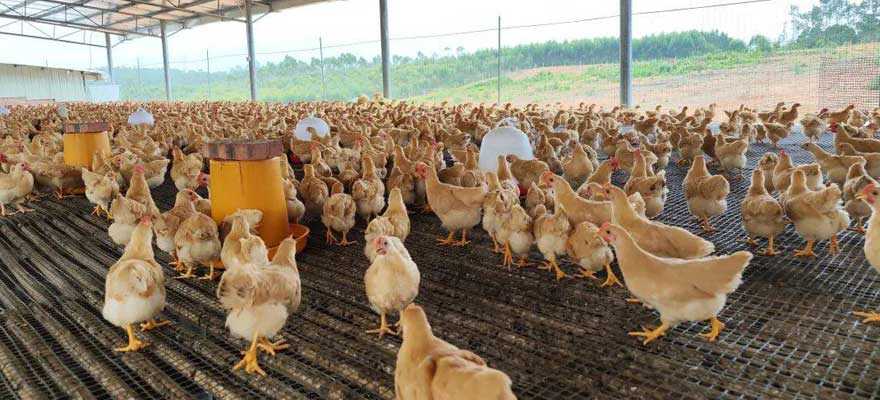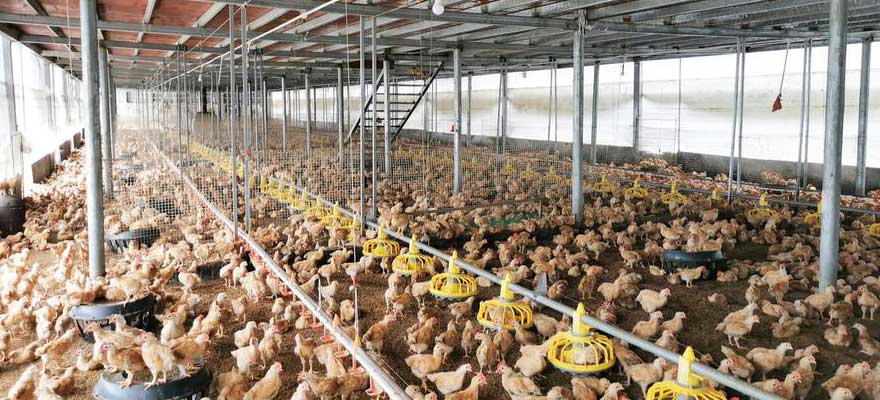Poultry House Plans for 1000 Chickens
Introduction
For chickens to be healthy, happy, and productive, they need to be housed properly. In addition to offering protection from the weather and predators, poultry houses also offer a controlled atmosphere that promotes healthy growth and development. In chicken housing, proper ventilation, lighting, and spacing are essential elements that have a direct impact on the general health and productivity of the birds.
The poultry house plans for 1000 chickens are friendly to small farm starters no matter if they use battery cages or floor housing methods. It takes careful design to guarantee that a 1000-chicken poultry house has enough room, ventilation, and food and water for every bird. We will go over important factors, design ideas, and best practices for building a housing structure that is both functional and efficient for a flock this size.
.jpg)
Planning Considerations
Location Selection and Site Preparation
- Choose a location that is well-drained and not prone to flooding.
- Ensure the site is accessible for delivery of feed, water, and other supplies.
- Consider proximity to markets and veterinary services.
- Clear the site of any obstacles and prepare a level foundation for the poultry house.
Size Requirements for Housing 1000 Chickens
- Calculate the space needed per bird based on breed and intended production system (e.g., free-range, cage-free, or intensive).
- Ensure there is enough space for feeding, watering, nesting, and perching areas.
- Consider future expansion needs if applicable. Ventilation and Airflow Considerations
- Provide adequate ventilation to remove excess moisture, ammonia, and other gases.
- Ensure proper airflow to maintain optimal temperature and air quality.
- Consider natural ventilation methods such as ridge vents and side vents, as well as mechanical ventilation options.
Biosecurity Measures
- Implement biosecurity protocols to prevent the introduction and spread of diseases.
- Control access to the poultry house and enforce strict hygiene practices for workers and visitors.
- Use footbaths, disinfectants, and other biosecurity measures to reduce the risk of disease transmission.
Designing the Poultry House
Selecting the Appropriate Housing Structure
Take into account the local weather and climate.
Analyze the benefits and drawbacks of constructions with open or closed sides.
Select a layout that makes feeding, watering, and cleaning simple.

Interior Design for Best Use of Space
Arrange the furniture to reduce crowded areas and maximize space efficiency.
Make sure there is enough room for areas for feeding and watering.
Make sure there is adequate room for every bird to fly about in comfort.
Considering Flooring
Select flooring materials that are simple to disinfect and clean.
Take into account the health and comfort of the birds (by providing litter for dust bathing and scratching, for example).
Boxes for nesting and Perches
Make sure there are enough nesting boxes for all the hens in the flock.
Make sure nesting boxes are located in a calm, dim area.
Install perches at varying heights to accommodate all birds and promote natural roosting behavior.
Building Materials and Techniques

Alternatives to building materials
Wood: economical and easy to process, but may require regular maintenance
Metal: durable and long-lasting, but can be more expensive.
Concrete: offers excellent durability and is easily cleanable, but it can be expensive.
Cost-effective construction techniques
Consider using locally sourced materials to reduce costs.
Explore prefabricated or modular construction options to assemble faster and more efficiently.
Use recycled or recycled materials whenever possible to reduce waste and costs.
Safety Considerations During Construction
Make sure all workers are trained in proper construction safety practices.
Wear appropriate personal protective equipment such as gloves, goggles, and hard. Hats
Follow local building codes and ordinances to ensure the safety and structural integrity of the poultry farm.
Equipment and Accessories

Feeding and Watering Systems
- Consider automatic feeding systems to ensure birds always have access to food.
- Install waterers that provide birds with clean, fresh water throughout the day.
- Clean and maintain feeders and waterers regularly systems to prevent contamination and disease.
Heating and cooling systems
- Depending on the climate, consider installing heaters to maintain optimal temperatures during colder months.
- Install fans or other cooling systems to prevent heat stress during hot weather.
- Monitor the comfort of the birds to ensure regular temperatures.
Lighting considerations
- Provide adequate lighting to keep birds on a regular day-night cycle.
- Consider using timers to control light schedules and simulate natural daylight.
- Use energy and efficient lighting to reduce costs and environmental impact.
Waste management systems
- Implement a waste management system to properly dispose of trash, manure and other waste.
- Consider composting or recycling waste materials to reduce environmental impact.
- Clean and maintain waste management systems regularly to prevent the spread of odors and pests.
Care and Maintenance
Regular Cleaning and Disinfection Practices
Establish a regular cleaning schedule for the aviary, including litter removal and surface disinfection.
Use appropriate cleaning agents and follow the manufacturer's instructions for disinfection.
Pay special attention. Areas where bacteria and pests are likely to accumulate.
Environmental monitoring and control
Regularly monitor the temperature, humidity and ventilation levels of the poultry house.
Make necessary adjustments to maintain optimal conditions for the birds.
Install sensors or alarms, which warn of major changes in environmental conditions.
Health Management Practices
Implement a health plan that includes vaccination schedules and regular health checks.
Monitor birds for signs of disease and take appropriate action. Act when problems arise.
Work closely with the veterinarian to ensure the health and well-being of the herd.
Budgeting and Cost Considerations

Initial setup costs
• Determine the cost of materials, labor and equipment needed to build the aviary.
• Include the cost of site preparation, building materials and any necessary permits or licenses.
• Consider buying or leasing land for the aviary. Ongoing maintenance and operating costs
• Estimate the cost of routine maintenance, including cleaning, repair and replacement of equipment.
• Consider operating costs such as electricity and water.
• Include the cost of nutrition, bedding and other bird care supplies.
Potential cost savings through efficient design and management practices
• Consider using energy efficient lighting and heating systems to reduce electricity costs
• Adopt waste management practices that reduce the need for disposal and potential environmental impact.
• Explore opportunities to source materials locally or use recycled materials to reduce initial installation costs.
Case Studies or Examples
Live examples of successful aviaries for 1,000 chickens
Example 1: A farm in Uganda built a semi-open aviary for 1,000 chickens, providing natural ventilation and protecting the birds from harsh weather conditions. This design improved the health and productivity of the birds.

Example 2: a poultry farm in Kenya adopted a closed poultry house with automated feeding and watering for a flock of 1,000 chickens. This design maximizes space utilization and minimizes labor costs, increasing efficiency and profitability.

Lessons learned from past projects
Good planning and site selection are critical to the success of an aviary project. Factors such as drainage, accessibility and proximity to resources can greatly affect the efficiency of housing.
Ventilation is key to maintaining a healthy environment for birds. Adequate airflow can help prevent moisture and ammonia build-up, which can cause respiratory problems and other health problems.
Regular maintenance and monitoring are essential to the longevity of the poultry farm and the health of the birds. Implementing a preventive maintenance plan can help prevent costly repairs and downtime.
Conclusion
Summary of key points discussed
- Proper storage is essential to the health, well-being and productivity of poultry.
- The design of a poultry house must consider location selection, size requirements, ventilation and biosecurity measures.
- Chicken houses include choosing the right construction, interior design, suitable flooring and provision of nest boxes and perches.
- Construction materials and techniques and safety considerations are important when building an aviary.
- Equipment and accessories such as feeding and watering, heating and cooling systems, lighting and disposal systems play a crucial role in the design of the aviary.
- Maintenance and management practices, including regular cleaning and disinfection, monitoring of environmental conditions and health. Management is essential to successful poultry farming.
- Budgeting and cost considerations and potential savings through effective design and management practices are important factors to consider.
The Importance of Proper Design and Planning for Successful Poultry Farmers
Proper planning and design in aviaries are essential for health, and indispensable for well-being and productivity.
A well-designed poultry house can help minimize disease outbreaks, reduce mortality rates, and improve overall efficiency and profitability.
Final Thoughts on the Future of Poultry House Design for Large-scale Operations
The future of poultry house design for large-scale operations is likely to focus on sustainability, efficiency, and animal welfare.
Innovations in technology, such as automated systems for feeding, watering, and environmental control, are expected to play a significant role in future poultry house designs.
Continued research and development in poultry house design will be essential for meeting the growing demand for poultry products while ensuring the health and well-being of the birds.
